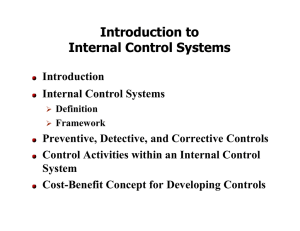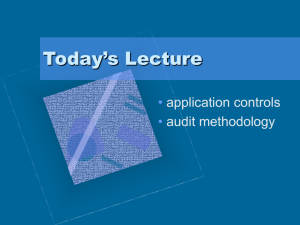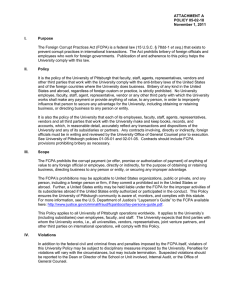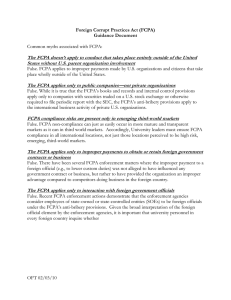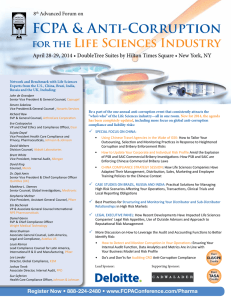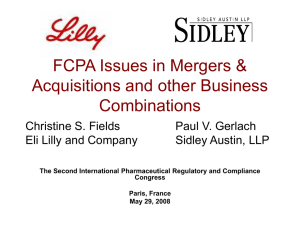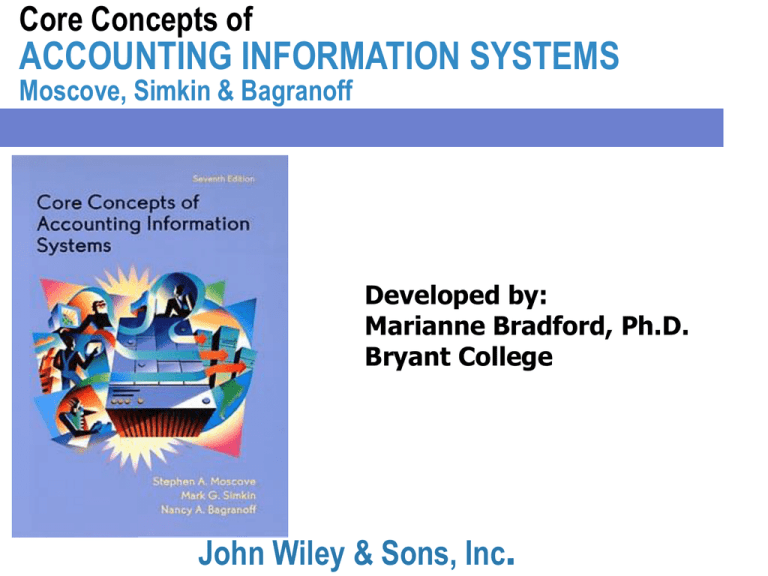
Core Concepts of
ACCOUNTING INFORMATION SYSTEMS
Moscove, Simkin & Bagranoff
Developed by:
Marianne Bradford, Ph.D.
Bryant College
John Wiley & Sons, Inc.
Chapter 7
Introduction to
Internal Control Systems
• Introduction
• Internal Control Systems: Definition and
Components
• Control Procedures Analyzed
• Cost-Benefit Concept for
Developing Controls
• Essential Elements of an Internal
Control System
Internal Control
• An internal control system consists of the
various methods and measures designed
into and implemented within an
organizational system to achieve four
main objectives.
Objectives of the Internal
Control Structure
• Safeguarding assets
• Checking the accuracy and reliability of
accounting data
• Promoting operational efficiency
• Encouraging adherence to
prescribed managerial
policies
Foreign Corrupt Practices Act
•
In 1977 the Foreign Corrupt Practices Act
(FCPA) was passed after the Securities and
Exchange Commission became aware of
foreign bribes paid by publicly held companies
to secure export sales.
• These bribes were made possible due to lax
internal controls.
• The goal of the FCPA was to heighten
awareness in a sound internal control structure.
Provisions of the Foreign
Corrupt Practices Act
• The FCPA requires that publicly held
companies design and implement a system
of control procedures that provide
reasonable assurance that:
•
•
•
•
assets are accounted for appropriately
transactions are in conformity to GAAP
access to assets is properly controlled
periodic comparisons of existing assets to the
accounting records are made
Committee of Sponsoring
Organizations
• As a result of the FCPA, a study was done by
the Treadway Commission to examine the
causes of fraudulent financial reporting and
give recommendations to reduce its
occurrence.
• The Committee of Sponsoring Organizations
(COSO) was formed to develop a common
definition for internal control and provide
guidance for judging its effectiveness.
Internal Control
•
Internal Control is a process, effected by an entity’s
board of directors, management and other
personnel, designed to provide reasonable
assurance regarding the achievement of objectives
in the following categories:
–
–
–
effectiveness and efficiency
reliability of financial reporting
compliance with applicable laws
and regulations
Information Systems Audit
and Control Foundation
• The ISACF examined the internal control area
and produced Control Objectives for
Information and Related Technology (COBIT).
• COBIT’s definition of internal control:
The policies, procedures, practices, and
organizational structures that are designed to provide
reasonable assurance that business objectives will be
achieved and that undesired events will be prevented,
detected and corrected.
Components of the Internal
Control Structure
•
•
•
•
Control Environment
Risk Assessment
Control Activities
Information and
Communication
• Monitoring
Control Environment
• The Control Environment establishes the tone of a
company, influencing the control awareness of the
company’s employees.
• Factors included within the control environment
are:
• Integrity, ethical values and competence of
employees
• Management philosophy and operating style
• The attention and direction of the board of
directors
• Assignment of authority and responsibility
Risk Assessment
• When designing controls for a company,
consideration must be given to the risk factor
by a process called risk assessment.
• Risk assessment recognizes that every
organization faces risks to its success.
• Risks come from internal and external sources.
• Risks that appear to affect the accomplishment
of a company’s goals should be identified,
analyzed, and acted upon.
Control Activities
• The policies and procedures that help
ensure that management directives are
carried out are the focus of
control activities.
Information and
Communication
• The term information refers to the accounting system,
which includes the methods and records used to record,
process, summarize and report a company’s
transactions and maintain accountability for assets,
liabilities and equity.
• Communication refers to providing a company’s
personnel with an understanding of their roles and
responsibilities pertaining to internal control over
financial reporting.
Monitoring
• The process that assesses the quality of internal
control performance over time is called
monitoring.
• Monitoring involves evaluating
the design and operation of controls
on a timely basis and initiating
corrective action when specific
controls are not functioning
properly.
Control Procedures Analyzed
• Control Procedures may be classified
according to their intended uses in a
system:
– Preventive Controls - designed to prevent some
potential problem from occurring when an
activity is performed
– Detective Controls - discover the occurrence of
adverse events such as operational inefficiency
– Corrective controls are designed to remedy
problems discovered through detective controls.
Interrelationship of Preventive
and Detective Controls
• Preventive and detective control
procedures should not be treated as
mutually exclusive.
• Rather, these controls are interrelated.
Cost-Benefit Concept for
Developing Controls
• A cost-benefit analysis should be
conducted in order to make sure that the
benefits of planned controls exceed the
cost of implementing them in the system.
• Controls are considered cost-effective when their
anticipated benefits exceed their anticipated costs.
• An ideal control is a control procedure that
reduces to practically zero the risk of an
undetected error or irregularity.
Cost Benefit Analysis
• The benefits of additional control
procedures result from risk of loss
reductions.
• A measure of loss should include both the
exposure (potential loss associated with a
control problem) and risk (probability
that the control problem will occur).
• Expected loss = risk * exposure
Essential Elements of an
Internal Control System
• A good Audit Trail
• Sound Personnel Policies and Competent
Employees
• Separation of duties
• Physical Protection of assets
• Internal Reviews of Controls by Internal
Audit Subsystem
• Timely Performance Reports
Good Audit Trail
• An audit trail enables auditors and accountants
within the organization to follow the path of
transaction data from the initial source
documents to the final disposition in a financial
report and vice-versa.
• Without a good audit trail,
it is more likely that errors
and irregularities in
processing data will not
be detected.
Sound Personnel Policies and
Competent Employees
•
Examples of sound personnel policies are:
1. Specific hiring procedures
2. Training programs
3. Good supervision
4. Fair and equitable guidelines for employees’
salary increases
5. Rotation of certain key employees in different
jobs
6. Enforced vacations
7. Insurance coverage on those employees who
handle liquid assets
8. Regular performance reviews
Separation of Duties
• Segregating activities and responsibilities of a
company’s employees allows different people
to perform various tasks of a specific
transaction.
• The main functions that should be kept
separate are custody of assets
recording transactions,
and authorizing
transactions.
Physical Protection of Assets
• Keeping a company’s assets in a safe physical
location minimizes the risk of damage to the
assets or theft by employees or outsiders.
• A voucher system is an example of an
accounting control procedure that protects
against unauthorized cash disbursements.
• A petty cash fund may be used for
small expenditures where writing
a check would be inefficient.
Internal Reviews of Controls
by Internal Audit Subsystem
• Internal audit is a service function within many
large companies.
• As a separate subsystem, they report to highlevel management or to the board of directors
in order to remain independent and objective.
• They perform periodic reviews, called
operational audits, on each department within
the organization in order to evaluate the
efficiency and effectiveness of that particular
department.
Timely Performance Reports
• Performance reports provide information to
management on how efficiently and effectively
its company’s internal controls are functioning.
• These reports should provide timely
feedback to management on the
success or failure of the company’s
internal controls.
Copyright
Copyright 2001 John Wiley & Sons, Inc. All rights reserved.
Reproduction or translation of this work beyond that permitted in
Section 117 of the 1976 United States Copyright Act without the
express written permission of the copyright owner is unlawful.
Request for further information should be addressed to the
Permissions Department, John Wiley & Sons, Inc. The purchaser may
make backup copies for his/her own use only and not for distribution
or resale. The Publisher assumes no responsibility for errors,
omissions, or damages, caused by the use of these programs or from
the use of the information contained herein.
Chapter 7

